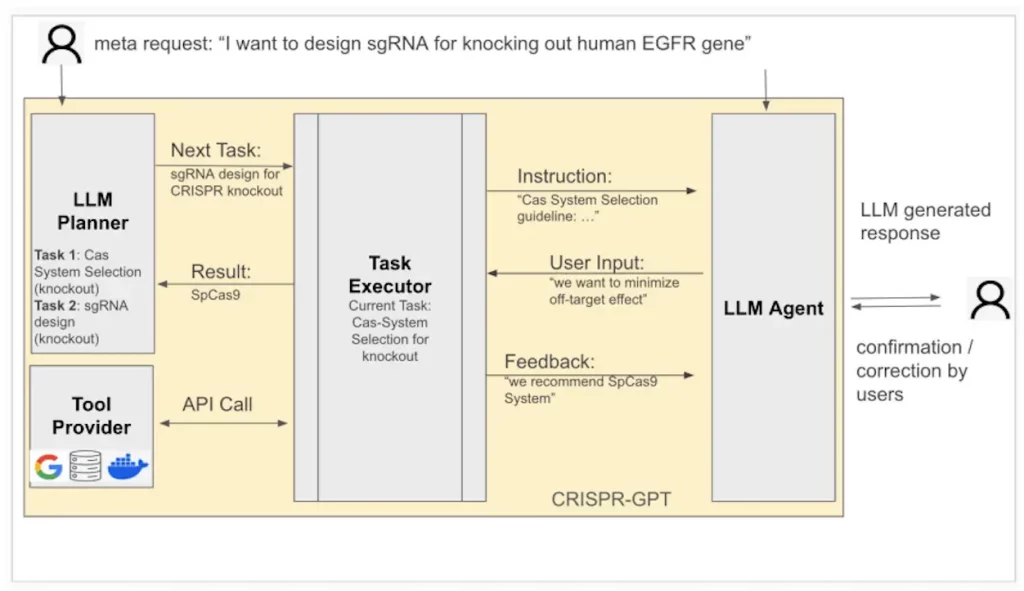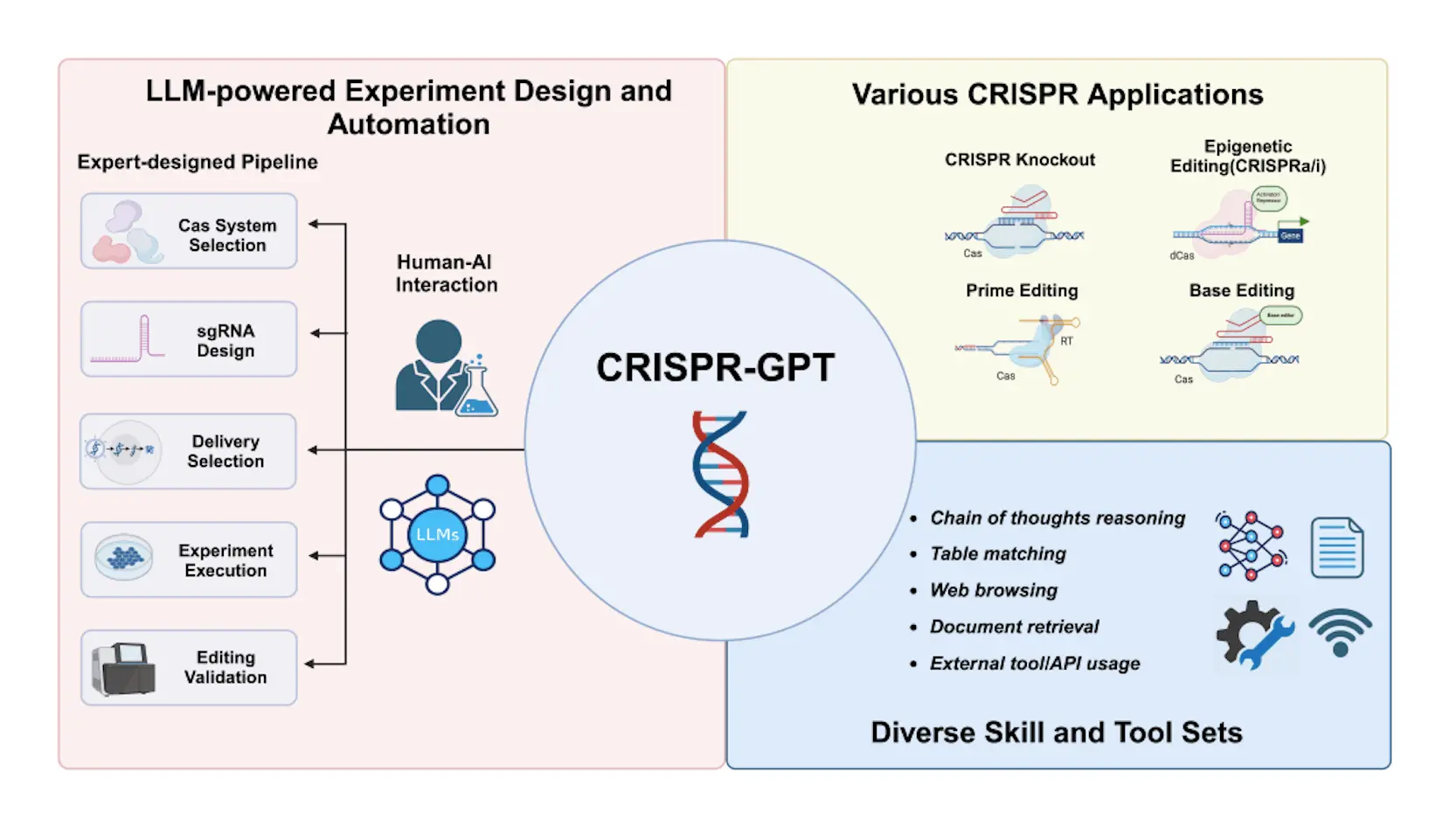The ability to precisely alter genes with CRISPR technology has revolutionized biomedical research. It does, however, take a thorough grasp of CRISPR technology and sophisticated experimental setups to design effective gene-editing systems. Despite its promise in various tasks, large language models (LLMs) sometimes lack specialized expertise and have difficulty correctly answering biological design puzzles. Researchers from Princeton University, Stanford University, and Google DeepMind present CRISPR-GPT, an LLM agent enhanced with external tools and domain expertise to improve and automate the process of designing CRISPR-based gene-editing studies. LLM agents, like CRISPR-GPT, have the potential to help non-expert researchers in gene-editing experiments. They can help choose CRISPR systems, create guide RNAs, suggest cellular delivery strategies, compose procedures, and create validation tests. This program bridges the knowledge gap between novice biologists and CRISPR genome engineering techniques by addressing ethical and regulatory issues related to automated gene-editing design. It also shows the potential of LLM agents in challenging biological discovery tasks.
Introduction
A remarkable scientific breakthrough, gene editing technology enables precise modifications to be made to the genetic makeup of living things. Applications of this technology include the correction of genetic abnormalities in diseases like hemophilia, sickle cell anemia, and cystic fibrosis; it also offers novel approaches to treating complicated problems such as cancer, cardiovascular disease, and neurodegenerative disorders. The well-known gene editing system CRISPR-Cas9 was developed from a naturally occurring bacterial genome editing mechanism. New developments include base editing, CRISPR-based prime editing, and CRISPR activation/interference. Prime editing is a DNA “search and replace” technique that enables precision editing without creating double-stranded breaks. Base editing adds even more tools to the toolbox for precision genome change by allowing direct, irreversible conversion of one DNA base into another at certain sites.
The short guide RNA is used in the CRISPR gene-editing technique to attach to a particular target sequence in a cell’s DNA. This procedure is similar to how the Cas enzyme cuts DNA at a specific spot in bacteria. The biology of the target organ must be understood in order to choose an appropriate system and design gene-editing experiments. It takes domain knowledge and trial-and-error work to build optimal guide sequences and validation approaches. AI-assisted computation tools have the potential to accelerate scientific and therapeutic advancements and increase accessibility to gene editing.
About Large Language Models (LLMs)
Reminiscent of artificial general intelligence, large language models (LLMs) have demonstrated remarkable linguistic abilities and world knowledge. They have been investigated for their potential to improve the efficiency and problem-solving skills of black-box optimizers and tool makers. In several application sectors, LLM-based models have been utilized to solve mathematical and scientific problems. Examples include Coscientist, which optimized a palladium-catalyzed cross-coupling synthesis successfully using GPT-4 and automated experimentation, and ChemCrow, which employs tool-augmented LM for chemistry-related activities.
Understanding CRISPR-GPT
A key tool in genetic engineering is CRISPR technology, which makes precise gene editing possible. However, there are difficulties in designing CRISPR trials, particularly for inexperienced researchers. By combining the advantages of Large Language Models with domain-specific expertise and computational tools designed especially for CRISPR gene editing tasks, CRISPR-GPT seeks to close this gap. The core of CRISPR-GPT is a tailor-made LLM-powered design and planning agent. The agent’s engine incorporates a variety of computational tools, such as the guide RNA design tool and a thorough analysis of recent research in addition to specialist information from top gene editing practitioners.
Gene-editing experiments are made easier by the CRISPR-GPT method, which breaks down the intricate procedure into smaller, more doable phases. This comprises determining which CRISPR system is best for the job, fine-tuning gRNA sequences, choosing the best delivery strategy, anticipating off-target effects, suggesting experimental procedures, and verifying modifications. With this method, which uses state machines and a chain-of-thought reasoning model, users can fine-tune their designs to suit certain research requirements. Additionally, CRISPR-GPT provides an Off-target Prediction Mode for in-depth examination of pre-designed gRNAs and a Freestyle Q&A Mode for impromptu queries. It also includes precautions to guarantee ethical and safety concerns, such as limitations on its application to human subjects, privacy controls for genetic information, and warnings about possible unexpected outcomes.

Limitations
CRISPR-GPT can create single elements, like primers and guide RNAs; it is now unable to create entire constructs or vectors from plain language input. This drawback attracts attention to a potential area for improvement. For instance, the integration of FragMID, a recent development in the field of modular gene-editing design, with CRISPR-GPT could realize the potential of LLMs to enable researchers to investigate and optimize CRISPR design and custom tactics, resulting in more effective gene-editing.
Conclusion
CRISPR-GPT streamlines and automates the process of designing intricate biological studies. Researchers may plan and carry out gene editing experiments more easily and effectively thanks to this system’s integration of LLMs with subject expertise, external tools, and a modular task execution system. Among the multi-modal features of the agent are interactive prompts, meta-task pipelines, and on-demand Q&A assistance. It tackles the challenges of conducting biological experiments using living materials by offering comprehensive, step-by-step instructions customized for the particular experimental setting. The agent is a valuable tool for researchers because of its ad hoc Q&A capabilities and freestyle prompting.
Article Source: Reference Paper
Important Note: arXiv releases preprints that have not yet undergone peer review. As a result, it is important to note that these papers should not be considered conclusive evidence, nor should they be used to direct clinical practice or influence health-related behavior. It is also important to understand that the information presented in these papers is not yet considered established or confirmed.
Follow Us!
Learn More:
Deotima is a consulting scientific content writing intern at CBIRT. Currently she's pursuing Master's in Bioinformatics at Maulana Abul Kalam Azad University of Technology. As an emerging scientific writer, she is eager to apply her expertise in making intricate scientific concepts comprehensible to individuals from diverse backgrounds. Deotima harbors a particular passion for Structural Bioinformatics and Molecular Dynamics.
















